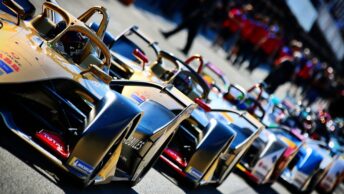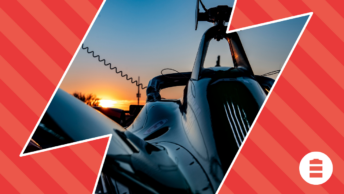The 2020-21 Formula E season kicks off tomorrow (Friday 26th February) in Diriyah, Saudi Arabia, and for some, it just might be the first Formula E race you’ve seen. Here’s a handy guide to how Formula E’s race day format works, and what to look out for as the day unfolds.
Formula E has a single-day race format. Instead of qualifying on one day and racing the next, everything is crammed into a single day. Here’s an explanation of all of the sessions and how each works.
The basic structure of the day is that you get free practice, followed by qualifying – which works out the order the cars line up in at the start – followed by a 45-minute race. Like everything else in Formula E, though, there are some twists unique to the series, even if you’re familiar with other forms of motorsport.

Free Practice
‘Free practice’ is exactly that – time for the teams to run on the track, without any specific limits on what they can do. They can do as many laps as possible or hardly any, depending on what they want to test or look into. It’s an opportunity to make sure the car is working well and that everything’s set up the way the driver likes it.
In Formula E, there aren’t too many opportunities to make big changes following practice because qualifying and the race take place soon after. Teams will have run simulations of different scenarios beforehand, and it will be down to the drivers and engineers to work out which one will benefit them the most once they’ve had a chance to spend some time out on track.
Formula E cars don’t have very much of what’s called telemetry either – basically, computer monitoring data off the car. So where in some other series you might hear the driver asking the pit wall (their engineers) what is going on with something, in Formula E you’re more likely to hear the engineers asking the drivers, as they have more information available to them via the dashboard.
Even so, it’s not very much and it’s hard to read while driving. So everything they can get – and discuss – during free practice is super important to what they can do in qualifying and the race.
On a regular E-Prix day (with only one race) there are two free practice sessions before qualifying. On a doubleheader weekend, qualifying for the second race will be as normal, but there’ll be only one practice session on that day. In Diriyah, because it’s a night race this time, the first practice session will run on Thursday evening to give the drivers and teams track time under the lights, then there will be a single free practice session before qualifying on both Friday and Saturday.
It might all sound a bit confusing but tune in and you’ll get to grips with it really quickly! The last thing to know is that drivers only get one lap during the free practice sessions at what they’ll refer to as ‘full power’ – this is the mode the cars switch to to do their fastest laps in qualifying.

Qualifying
Formula E qualifying takes place in groups, which are worked out by championship order. For the Diriyah races, as it’s the first of the season, they’ll be worked based on where the drivers finished in last season’s championship – with anyone new to Formula E ranking last (and therefore qualifying in the last group).
That might sound mean but actually being first out in Group 1 (where the points leaders will be placed) can be a disadvantage. Formula E tracks are dusty and dirty – it’s the nature of using city tracks – so often a cleaner line will develop where cars have driven through that dust, creating more grip as the groups go on. That’s why you often hear the championship leaders complaining about being out first but, ultimately, it’s probably the fairest way to decide it for now.
Each of the four qualifying groups will feature six drivers who can go out at any time they like during the four minutes of their session. There’s a tendency for drivers to wait until the last minute in order to try and gain an advantage by being the last one out on, theoretically, a gripper track. That doesn’t always play out well, however, as the track is often at its most crowded and it could even result in the driver not getting enough time to set a lap time, putting themselves at the back of the grid. Sometimes being the early bird definitely pays off!
When you’re watching group qualifying, look out for the fastest lap time in Group 1 and see if Group 2 are easily matching or beating it. If so, the track is developing quickly and the subsequent groups have a good chance of being in the fastest six times – which wins them a place in Super Pole.
Super Pole
The top six in qualifying get to advance to a final session called Super Pole. They essentially re-run their qualifying lap, against only each other, to work out their order on the front three rows of the grid.
Sometimes Super Pole times are slower than group qualifying, partly because the cars have been sitting still between their group qualifying and Super Pole sessions. Tyres and brakes might be either a bit knackered from the groups or too warm. Formula E cars don’t change tyres as much as you’ll see in other motorsport series – they only get two sets to potentially swap from the start of the race day to the end.
That doesn’t matter too much though, since Super Pole drivers are only competing against each other having qualified for the top six already. They go out one-by-one in reverse order (the driver who was sixth fastest goes out first, fifth fastest next, and so on) and once they have set their lap, all they can do is watch on to see what the others can muster.

THE RACE
A Formula E race, or an E-Prix to use its official title, takes place usually only a couple of hours after qualifying. Once the starting order has been decided (it sometimes changes a bit post-qualifying due to penalties handed if drivers or teams have made mistakes or have broken the rules) it’s time to assemble the grid and GO GREEN!
The race lasts for 45 minutes plus one lap. When the race leader crosses the start/finish line after 45 minutes, that will be the final lap. It’s not a hard time limit and occasionally Formula E races can take quite a lot longer than that, for example, if there’s a crash that brings out a red flag, but in terms of the time spent actually racing, that’s how it’s accounted for.
Unlike other series you might have watched, such as Formula 1, there are no pitstops during the race. Formula E doesn’t have refueling (for obvious reasons) and there are no tyre changes permitted aside from punctures or repairs. To create a tactical element in place of pit stops, Formula E has a unique feature called ‘Attack Mode’.
Attack Mode allows a driver to have a higher top power output for a few minutes. Formula E cars use up to 200kW of power for most of the race, but once Attack Mode is activated, they can use up to 235kW. That doesn’t mean they automatically go faster all the time – just that if they really floor it, there’s a bit more power they can access.
That can come in handy for overtaking but it’s also hard not to be overtaken when they run over the Attack Mode activation zone – a part of the track they have to pass through to be able to activate Attack Mode on the cars. It sounds strange but you’ll see it easily once you’re watching the race.
Attack Mode energy comes from the same battery allowance they use for the race, so anything extra they use has to be managed. They also have to work out if their tyres, brakes, and powertrain could take the strain from using more power – so even when it’s activated you might see them using it sparingly, maybe just to set up one impressive overtake.
Needless to say, whoever passes the chequered flag first is the winner (unless they’re disqualified later, a Formula E tradition) and points are awarded to the top 10 finishing drivers. There’s an additional prize for the driver with the fastest lap, if they finish in the top 10.
The Diriyah E-Prix kicks off Formula E’s seventh season, this evening on Thursday 25th February. Keep your eyes glues to the Inside Electric Twitter account for the latest updates.





